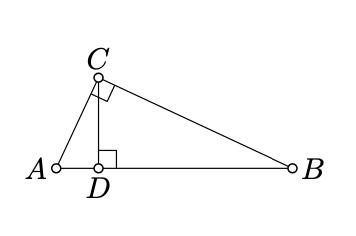6.2: Pythagorean theorem
( \newcommand{\kernel}{\mathrm{null}\,}\)
A triangle is called right if one of its angles is right. The side opposite the right angle is called the hypotenuse. The sides adjacent to the right angle are called legs.
Assume
- Proof
-

Let
According to Lemma 5.5.1,
and
Therefore,
Note that by the AA similarity condition, we have
In particular,
Let us rewrite the two identities in 6.2.2:
Summing up these two identities and applying 6.2.1, we get that
Assume
The following exercise is the converse to the Pythagorean theorem.
- Hint
-
Apply that
Assume that
Prove that the angle at
- Hint
-
Apply the Pythagorean theorem


